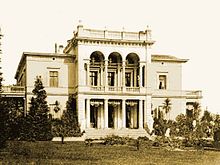Rieterpark
The Rieterpark is the park in the Enge district in Zurich that belonged to Villa Wesendonck in 1855 and was first owned by the Wesendonck family and later owned by the Rieter family. The park is the largest and largely original landscape park in Zurich from the 19th century and is now a public park for the city of Zurich .
history

Wesendonck family (1855 to 1871)
In the middle of the 19th century, the German merchant Otto Wesendonck bought a large piece of land on the "Gabler", a hill in the then still independent municipality of Enge near Zurich. He had a mansion , the Villa Wesendonck , designed by the well-known architect Leonhard Zeugheer and the associated park by the art gardener Theodor Froebel . He then moved into this system together with his wife Mathilde.
As a major art sponsor, the Wesendoncks granted Richard Wagner their hospitality from 1849 . Wagner had to leave Germany because of his participation in the liberal March Revolution . He was allowed to live in a house specially prepared for him opposite the Villa Wesendonck. Otto Wesendonck had bought this modest half-timbered house from 1850 at an inflated price to prevent the plans of the neurologist Ludwig Binswanger , who had bought the building in 1856 to set up a psychiatric clinic there.
Mathilde Wesendonck became Wagner's lover and Wagner therefore wrote his Wesendonck songs in Zurich . In 1858 Wagner ended both his affair with Mathilde Wesendonck and his marriage to his wife Minna and fled Zurich. In 1871 the Wesendoncks finally sold the facility they had created, now called "the green hill", and traveled back to Germany.
Rieter family (1871 to 1945)
In 1871 the industrial family Rieter from Winterthur bought the entire property. The facility was expanded to include the Park Villa Rieter. After the death of Adolf Rieter-Rotpletz (1882), his son Fritz Rieter had the old half-timbered house expanded and converted into the Villa Schönberg by Alfred Friedrich Bluntschli so that his widowed mother-in-law Henriette Elisabeth Bodmer-Pestalozzi could live there. At the same time, Bluntschli, who later also designed the nearby Enge Church , built the Villa Rieter , in which Bertha Rieter-Bodmer hosted the German Emperor Wilhelm II as a guest for a few days in 1912 .
The Rieter family was ultimately also the namesake for today's Rieterpark and Rietberg. Also on behalf of Fritz Rieter, the utility building and the orangery were built by Adolf Brunner in 1887 .
City of Zurich (1945 to today)
In 1945, following a referendum, the city of Zurich bought the 68,000 m² Rieterpark and the Villa Wesendonck from the Rieter family for 2.9 million francs. The Villa Schönberg remained in the family's possession until 1970. This park was now open to the public for the first time.
By popular resolution in 1949, the reconstruction of the Villa Wesendonck and its use as a museum for non-European culture was determined. The foundation stone was formed by the donation from Baron Eduard von der Heydt to the city of Zurich, which has been presented to the public since the opening of the Rietberg Museum in 1952 (and with a new extension from 2007).
When the community of heirs of the Rieter family sold Villa Schönberg in 1970 and it was threatened with demolition, the city of Zurich bought it in 1976 and placed the entire ensemble (Rieterpark, Villa Wesendonck, Villa Rieter and Villa Schönberg) under a preservation order . In 1978 part of the Rietberg Museum was opened in the Villa Schönberg.
Park
The park is oriented to the south and rises gently from the villa. When the weather is nice, you can have a view of the Glarus Alps. On December 26, 1999, parts of the Rieter Park were severely damaged by Hurricane Lothar .
Artwork in the park
Youth with hawk
bronze, 220 cm
Werner Friedrich Kunz (1934)Shepherd
bronze, 102 cm
Alice Boner
Bronze bust of Wagner , 1885
Fritz Schaper
Individual evidence
- ↑ Park and green areas. ( Memento of the original from May 27, 2011 in the Internet Archive ) Info: The archive link was inserted automatically and has not yet been checked. Please check the original and archive link according to the instructions and then remove this notice. Website of the City of Zurich, Green City of Zurich. Retrieved July 28, 2010.
- ^ Herbert Pachmann: Zurich showpieces: sculptures in the public space of the city. BoD, 2014, pp. 71-72. on-line
Web links
Coordinates: 47 ° 21 '30.6 " N , 8 ° 31' 50.7" E ; CH1903: six hundred eighty-two thousand five hundred and five / 245869











